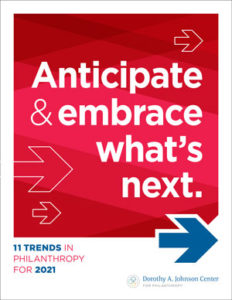It’s Getting Harder and Harder to Distinguish Philanthropy and Business


 For the 11 Trends in Philanthropy for 2019 report, I wrote an essay titled, “The Boundaries Are Blurring Between Philanthropy and Business.” We knew that trend was progressing rapidly, but the last couple of years have seen the pace of blurring accelerate. The events of 2020 have now put this trend in particularly stark relief, and raised difficult questions for the future of philanthropy.
For the 11 Trends in Philanthropy for 2019 report, I wrote an essay titled, “The Boundaries Are Blurring Between Philanthropy and Business.” We knew that trend was progressing rapidly, but the last couple of years have seen the pace of blurring accelerate. The events of 2020 have now put this trend in particularly stark relief, and raised difficult questions for the future of philanthropy.
The creation of the Chan Zuckerberg Initiative (CZI) in late 2015 as a charitable LLC — a for-profit entity being used for nonprofit, philanthropic purposes — was a signal moment in this trend. Other billionaires have now followed suit, including Laurene Powell Jobs, the widow of Apple founder Steve Jobs, and John and Laura Arnold, who recently converted their family foundation to an LLC, Arnold Ventures. Two other well-known examples of this trend — the rise of socially responsible B Corps and increased popularity of impact investing — have also continued to spread, infusing both the consumer and investment landscapes with concerns about social responsibility while complicating further our answer to what is philanthropy and what is business.
More broadly, a commitment to charitable giving and social benefit is increasingly seen as a necessary and profitable aspect of any business. CSR (corporate social responsibility) is more widespread than ever, dominating MBA curricula and business publications alike (Janes & Rau, 2020). AmazonSmile makes combining charity and shopping easy. And even multi-trillion-dollar investment firm BlackRock now requires companies in their portfolio to demonstrate their social contributions (Ross Sorkin, 2018). An article in the Harvard Business Review even predicted, “We are entering the age of corporate social justice” (Zheng, 2020). This is certainly a far cry from 1983, when American Express first introduced the idea we know as cause-related marketing — contributing a small amount to charity for each purchase with the card. At the time, this and other similar efforts were met with strong skepticism and concerns that they would turn charity into just another marketing gimmick (Gottlieb, 1986). Today, the practice is widespread and normalized, even expected.
The array of new models and jargon used to describe this hybrid business-philanthropy space is also, of course, growing every year. It is hard to keep up, even for the most avid proponents (Boyle, 2017).
“[A]s philanthropy and business continue to blur, we need to keep our eyes open for when and where strategic and healthy limits to this blurring — in our practices and our thinking — are needed.”
At the same time, the pressure on nonprofits to act more “businesslike” continues apace, even leading some nonprofits to launch for-profit businesses to generate much-desired “sustainable” revenue (Brody, 2019). Dan Pallotta’s TED talk calling for charities to market themselves like businesses has 5 million views and counting (2013). Yet along with this pressure often comes frustration and confusion among nonprofit professionals. As popular commentator Vu Le (2019) lamented, nonprofits face “the frustrating reality… that we are judged as businesses without [being] given the rights and resources to fully operate as businesses” (para. 3).
As I noted in my 2019 essay, this blurring of the philanthropy-business boundary is not new, historically speaking. But never before has the boundary been changing so fundamentally and rapidly, and never before has it been so widely popular and promoted.
It should be no surprise, then, that when the multiple crises and social unrest of 2020 hit, many of the responses to those crises followed this multi-sectoral pattern. Patronizing local businesses struggling during the pandemic was promoted as a socially beneficial — even philanthropic — act. In the wake of the Black Lives Matter uprising, supporting Black-owned businesses became a way to help minority communities, beyond (and perhaps instead of) traditional charitable giving. Companies created new ads touting their social commitments and charitable engagements. Many nonprofits and grantmakers turned new attention to nurturing local economic development.
However, we are also seeing in 2020 some renewed attention to good old-fashioned charity — e.g., donors working to get cash directly in the hands of those in most need, people giving to COVID relief funds at the United Way or local community foundation (Stiffman, 2020). The pressure for nonprofits to be more businesslike has lessened a bit, it seems (if temporarily), as many nonprofits struggle to survive. They need emergency core support and cannot focus right now on long-term, revenue-generating ventures.
Still, there is little doubt that, once we are on the other side of our current social upheaval and uncertainty, the move to redefine the business-philanthropy boundary will continue. For one thing, we know that young people are not only comfortable with this hazy boundary, but embrace it. There is evidence that millennials and Gen Z, who seek to create change or respond to crises like those we face now, often turn to making new consumer choices as much or more than making new philanthropic choices (Jones, 2020). Younger investors are also the ones most interested in impact investing, and younger employees are the ones pushing hardest for companies to do more CSR (U.S. Trust, 2017).
If we are to live in — and try to do good in — an increasingly blurry, hybridized world, the question then is what is good about this trend and what is troubling. Only time will tell, of course. But in recent years, we have begun to see some of the positives — and, alas, some negatives.
Nonprofits successfully using business practices to generate more sustainable revenue is certainly a positive. The intensified interest in supporting Black-owned businesses and investing in local economies surely advances the public good in ways most of us hope will continue. Corporations as well as investors incorporating social, environmental, and philanthropic considerations into their decision-making is a welcome antidote to the dark tendencies of predatory or other bad forms of capitalism — even if this social responsibility is occasionally used in cynical ways to distract from or whitewash harmful business outcomes.
But there are cautionary signs as well. For one, the social entrepreneurs working in this hybrid space are still trying to find models that work. The much-celebrated B Corp Tom’s Shoes recently had to modify their core “buy-one, give-one” approach to stay afloat and to avoid disrupting local economies where they gave away shoes, and Panera’s experiment with opening nonprofit “pay-what-you-can” restaurants failed (Stych, 2019; Peters, 2018).
Even more troubling is the possibility that this turn toward “doing good” in ways beyond traditional giving and nonprofits has contributed to the documented decrease in traditional giving and volunteering — and will continue to do so. The percentage of Americans who say they give to charity is declining, and volunteering rates are down as well (Rooney, 2019; Grimm, & Dietz, 2018). A crucial question going forward is whether this decline will continue as more people — especially younger generations — come to see the best path to social change as one going through the marketplace — through what they buy, how they invest, and which social enterprises they work for.
What this means is that, as philanthropy and business continue to blur, we need to keep our eyes open for when and where strategic and healthy limits to this blurring — in our practices and our thinking — are needed. We must find and learn from cases when this has worked, when it has been sustained, and when it has preserved fundamental philanthropic values even while taking advantage of business values. Making philanthropy and business indistinguishable shouldn’t be the goal.
Boyle, A. (2017, January 17). Glossary for good 2.0 – 27 models + approaches for organizations doing good. RoundPeg. https://www.roundpegcomm.com/glossary-good-2-0-28-models-approaches-organizations-good
Brody, L. (2019, August 26). Why charities are launching for-profit businesses. Entrepreneur. https://www.entrepreneur.com/article/337547
Gottlieb, M. (1986, July 6). Cashing in on a higher cause. The New York Times. https://www.nytimes.com/1986/07/06/business/cashing-in-on-higher-cause.html
Grimm, R. T., Jr., & Dietz, N. (2018). Where are America’s volunteers? A look at America’s widespread decline in volunteering in cities and states. Research Brief: Do Good Institute, University of Maryland. https://dogood.umd.edu/sites/default/files/2019-07/Where%20Are%20Americas%20Volunteers_Research%20Brief%20_Nov%202018.pdf
Janes, P., & Rau, O. (2020, January 16). Corporate social responsibility employs many models to strategically align business and philanthropy. 11 trends in philanthropy for 2020. Dorothy A. Johnson Center for Philanthropy. https://johnsoncenter.org/blog/corporate-social-responsibility-employs-many-models-to-strategically-align-business-and-philanthropy/
Jones, R. (2020, May 22). Young people prefer shopping to traditional gift giving. That’s a challenge for nonprofits. Chronicle of Philanthropy. https://www.philanthropy.com/article/young-people-prefer-shopping-to-traditional-giving-thats-a-challenge-for-nonprofits
Le, V. (2019, April 3). Hey, you want nonprofits to act more like businesses? Philanthropy Daily. https://www.philanthropydaily.com/hey-you-want-nonprofits-to-act-more-like-businesses
Moody, M. (2019, February 13). The boundaries are blurring between philanthropy and business. 11 trends in philanthropy for 2020. Dorothy A. Johnson Center for Philanthropy. https://johnsoncenter.org/blog/the-boundaries-are-blurring-between-philanthropy-and-business
Pallotta, D. (2013, March). The way we think about charity is dead wrong. [Video]. TED Conferences. https://www.ted.com/talks/dan_pallotta_the_way_we_think_about_charity_is_dead_wrong
Peters, A. (2018, June 8). Why Panera’s experiment with pay-what-you-want dining failed. Fast Company. https://www.fastcompany.com/40582757/why-paneras-experiment-with-pay-what-you-want-dining-failed
Rooney, P. (2019, December 4). Where have all the donors gone? The continued decline of the small donor and the growth of megadonors. Nonprofit Quarterly. https://nonprofitquarterly.org/where-have-all-the-donors-gone-the-continued-decline-of-the-small-donor-and-the-growth-of-megadonors
Ross Sorkin, A. (2018, January 15). BlackRock’s message: Contribute to society, or risk losing our support. The New York Times. https://www.nytimes.com/2018/01/15/business/dealbook/blackrock-laurence-fink-letter.html
Stiffman, E. (2020, October 6). Giving was up 7.5% in the first half of 2020, new report says. Chronicle of Philanthropy. https://www.philanthropy.com/article/giving-was-up-7-5-in-the-first-half-of-2020-new-report-says
Stych, A. (2019, November 25). Toms changes its ‘buy one give one’ charitable model. Bizwomen. https://www.bizjournals.com/bizwomen/news/latest-news/2019/11/toms-changes-its-buy-one-give-one-charitable-model.html
U.S. Trust. (2017). 2017: The generational collide. https://www.privatebank.bankofamerica.com/publish/content/application/pdf/GWMOL/USTp_WW_FindingsOverview_Broch_Final.pdf
Zheng, L. (2020, June 15). We’re entering the Age of corporate social justice. Harvard Business Review. https://hbr.org/2020/06/were-entering-the-age-of-corporate-social-justice